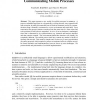Free Online Productivity Tools
i2Speak
i2Symbol
i2OCR
iTex2Img
iWeb2Print
iWeb2Shot
i2Type
iPdf2Split
iPdf2Merge
i2Bopomofo
i2Arabic
i2Style
i2Image
i2PDF
iLatex2Rtf
Sci2ools
BIRTHDAY
2004
Springer
2004
Springer
Communicating Mobile Processes
This paper presents a new model for mobile processes in occam-π. A process, embedded anywhere in a dynamically evolving network, may suspend itself mid-execution, be safely disconnected from its local environment, moved (by communication along a channel), reconnected to a new environment and reactivated. Upon reactivation, the process resumes execution from the same state (i.e. data values and code positions) it held when it suspended. Its view of its environment is unchanged, at is abstracted by its synchronisation (e.g. channels and barriers) interface and that remains constant. The environment behind that interface will (usually) be completely different. The mobile process itself may contain any number of levels of dynamic sub-network. This model is simpler and, in some ways, more powerful than our earlier proposal, which required a process to terminate before it could be moved. Its formal semantics and implementation, however, throw up extra challenges. We present details and perf...
Applied Computing | BIRTHDAY 2004 | Local Environment | Mobile Processes | Process Resumes Execution |
| Added | 01 Jul 2010 |
| Updated | 01 Jul 2010 |
| Type | Conference |
| Year | 2004 |
| Where | BIRTHDAY |
| Authors | Peter H. Welch, Fred R. M. Barnes |
Comments (0)

